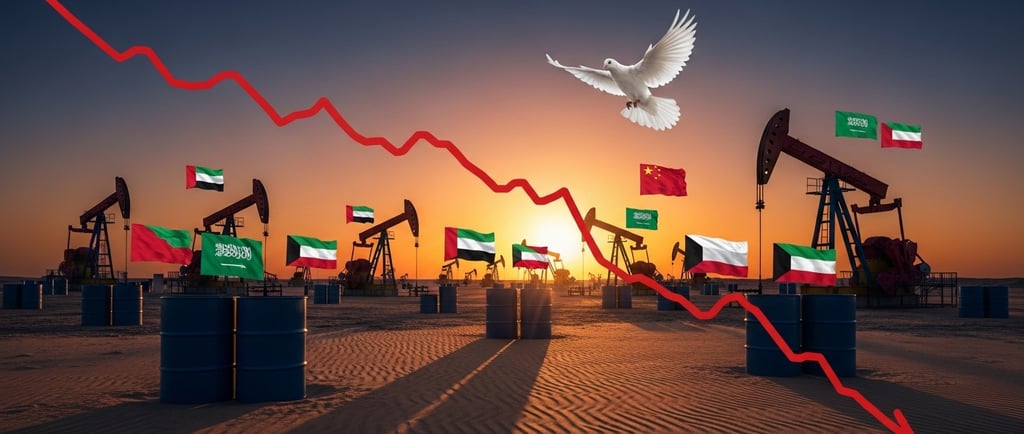Oil Prices Plunge to 5-Month Low: Gaza Ceasefire and US-China Trade War Shake Energy Markets
Crude oil hits lowest levels since April as geopolitical tensions ease and trade fears rise
Cristian Ianowich
10/14/20254 min read


Crude oil hits lowest levels since April as geopolitical tensions ease and trade fears rise
If you've been keeping an eye on energy markets, you probably noticed something dramatic happening: oil prices just took a serious dive. On Friday, October 10th, crude oil dropped to its lowest level in five months, and there are two major reasons why.
Let me walk you through what's happening and why this matters—not just for gas prices at the pump, but for anyone interested in commodities trading or global economics.
How Far Did Oil Prices Actually Fall?
The numbers tell a striking story:
West Texas Intermediate (WTI) crude for November delivery: Down 4.24%, settling at $58.90 per barrel—the lowest since April
Brent crude from the North Sea for December delivery: Dropped 3.82%, landing at $62.73 per barrel
These aren't small moves. In the oil market, a 4% drop in a single day is significant and usually signals major shifts in global dynamics.
So what caused this sudden selloff? It's actually a combination of two completely different factors working together.
Reason #1: The Gaza Ceasefire Reduces Risk Premium
Oil prices started falling early in the trading session when the ceasefire between Israel and Hamas officially took effect in Gaza.
Now, you might be thinking: "Israel isn't even a major oil producer, so why does this matter?"
Great question! Here's the thing—it's all about risk perception.
As analyst Lukman Otunuga from FXTM explained, this agreement "reduces geopolitical risk" and eases "fears related to supply disruptions."
Why Middle East Conflicts Affect Oil Prices
Even though Israel doesn't pump much oil itself, the real concern has always been about conflict spreading to the wider region. Remember what happened in June? The 12-day war between Iran and Israel sent oil prices soaring because traders feared:
Potential disruptions to shipping routes through the Strait of Hormuz
Attacks on oil infrastructure in major producing countries
Regional instability affecting Saudi Arabia, Iraq, and other major exporters
With the Gaza ceasefire in place, that "risk premium" built into oil prices started evaporating. Traders who had been betting on continued conflict and potential supply disruptions suddenly had to reassess their positions.
Understanding how geopolitical events impact commodity prices is crucial for anyone looking to trade or invest in energy markets. These aren't just abstract news events—they directly affect your portfolio.
Reason #2: US-China Trade Tensions Threaten Demand
Just when the market was digesting the ceasefire news, oil prices fell even further. What changed?
President Donald Trump posted on social media that China "was becoming too hostile" and that he would be "forced to retaliate financially" following China's restrictions on rare earth elements.
Trump also hinted at broad tariff increases on Chinese products entering the United States.
Why Trade Wars Crush Oil Demand
Here's where economics 101 comes into play: trade wars slow down economic activity, and when economies slow down, they use less energy.
Investors are worried that escalating trade tensions could:
Reduce manufacturing activity in both countries
Slow global economic growth
Decrease transportation and shipping needs
Lower overall demand for crude oil
It's a domino effect: tariffs → slower economy → less oil consumption → lower prices.
Want to protect your investments during trade uncertainty? Understanding these economic connections helps you anticipate market moves before they happen.
The Supply Side Problem: Too Much Oil Coming
But wait—there's more to this story than just reduced risk and demand concerns.
Analysts at DNB Carnegie pointed out "clear signs of the long-awaited oversupply in the oil market."
The evidence? A significant increase in oil volume in maritime transit, which is an early indicator of rising inventories in the coming months.
OPEC+ Adding Millions of Barrels
In just a few months, eight members of the Organization of the Petroleum Exporting Countries and their allies (OPEC+) have already revised their production quotas upward by more than 2.5 million barrels per day.
Let's put that in perspective: 2.5 million barrels per day is roughly equivalent to the entire oil consumption of a country like Japan.
More supply + weaker demand = lower prices. It's basic economics, but the impact on your energy investments can be substantial.
What Does This Mean for Consumers and Investors?
For Everyday Consumers:
Lower crude oil prices typically translate to cheaper gasoline at the pump within a few weeks. If you're budgeting for fuel costs, this could provide some relief.
For Investors and Traders:
This situation creates both challenges and opportunities:
Challenges:
Traditional energy stocks may face pressure
Oil-producing countries' currencies could weaken
Companies dependent on higher oil prices might struggle
Opportunities:
Industries that benefit from lower energy costs (airlines, shipping, manufacturing) could see improved margins
Potential buying opportunities in oversold energy stocks
Strategic positions in alternative energy sectors
The key question is: Are you prepared to navigate these market shifts? Understanding the interplay between geopolitics, trade policy, and commodity prices isn't just interesting—it's essential for making informed investment decisions.
The Bigger Picture: A Perfect Storm for Oil
We're witnessing a rare convergence of factors all pushing oil prices in the same direction:
Reduced geopolitical risk (Gaza ceasefire)
Weakening demand outlook (trade war fears)
Increasing supply (OPEC+ production increases)
When these three forces align, they create powerful price movements that can catch unprepared investors off guard.
What's Next for Oil Prices?
While nobody has a crystal ball, several factors will likely influence oil prices in the coming weeks:
How long the Gaza ceasefire holds and whether regional tensions truly ease
The outcome of US-China trade negotiations and whether tariffs are actually implemented
Global economic data showing actual demand levels
OPEC+ decisions on whether to continue increasing production
The volatility we're seeing isn't going away anytime soon. If anything, the intersection of geopolitics and economics will continue creating dramatic price swings.
The Bottom Line: Knowledge Is Your Best Investment
Oil prices hitting five-month lows on a single Friday shows just how quickly markets can shift. One day it's about Middle East peace, the next it's about trade wars—and often it's both at once.
For anyone trading commodities, investing in energy stocks, or simply trying to understand how global events affect their wallet, staying informed is crucial.
The investors who understand these connections—who can see how a ceasefire in Gaza and a tweet about China can both move the same market—are the ones positioned to make smarter decisions.
Ready to decode complex market movements like a pro? The difference between reacting to price changes and anticipating them comes down to understanding the fundamental forces at play. Whether prices go up or down from here, one thing is certain: those who understand the "why" will always have an edge over those who only see the "what."
